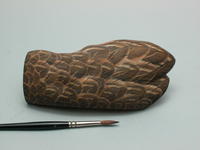A Side of Side Pockets
It's just one part of a decoy--but it's an important one.

Glenn McMurdo’s interest in decoy carving began in 1985. Since then Glenn, now a master carver, has written numerous how-to articles and has judged carving competitions from coast to coast across Canada and the United States. His most recent Workbench Project is Green-Winged Teal Pair. Email mcmurdocarvings@sympatico.ca or phone (905) 372-5821.Castings of this side pocket or full life-size castings of other species are available.
A decoy is more than the sum of its parts, of course, but it’s still necessary to get all the different areas right if you want a realistic bird. In this article, I concentrate on just one aspect of a duck—the side pockets. I try to give some softness to the final product in this area by carving lumps and bumps and adding soft shadows and highlights to the surface. I paint the darker areas to enhance the shadows and make the lighter areas complement the shadowed portions. This adds more softness. Although this side pocket is from a mallard hen, you can use these techniques with different colors for the side pockets of many waterfowl.
This article is from Wildfowl Carving Magazine’s Spring 2014 issue.
Read NextThe Value of Value



